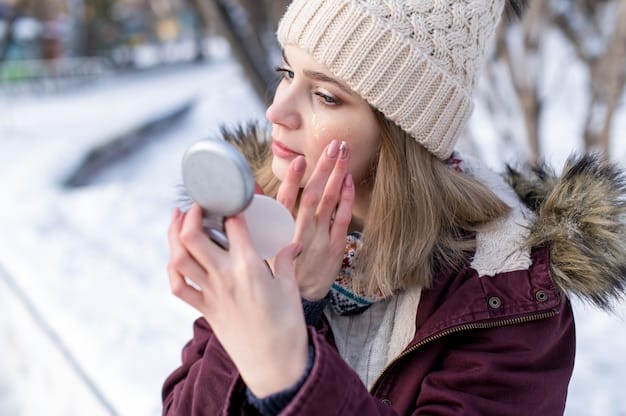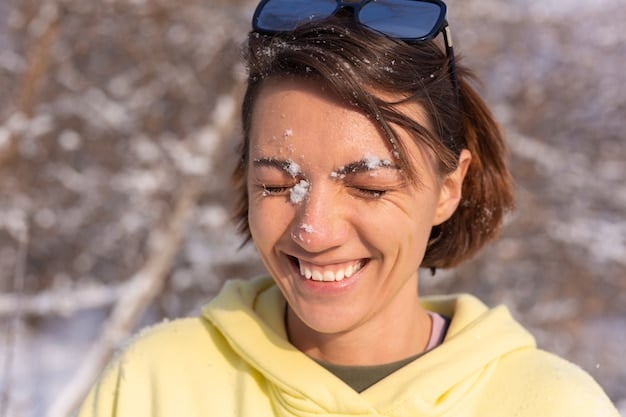How to Take Care of Your Skin in the Winter: Expert Tips

Taking care of your skin in the winter involves adjusting your skincare routine to combat dryness, protect against harsh weather conditions, and maintain hydration to keep your skin healthy and radiant.
Winter can be harsh on your skin, leading to dryness, irritation, and discomfort. But with the right approach, you can maintain a healthy and radiant complexion even in the coldest months. Let’s explore how to take care of your skin in the winter, ensuring it stays nourished and protected.
Understanding Winter Skin Challenges
Winter brings unique challenges to skincare. The combination of cold outdoor air, dry indoor heating, and harsh winds can strip your skin of its natural moisture, leading to a variety of issues. Recognizing these challenges is the first step in creating an effective winter skincare routine.
Let’s delve into the specific problems your skin faces during winter:
The Impact of Cold Weather
Cold air holds less moisture, making it a natural dehydrator. When exposed to cold temperatures, your skin’s natural barrier can become compromised, leading to increased water loss and dryness.
The Dryness of Indoor Heating
Central heating systems and fireplaces, while essential for warmth, significantly reduce indoor humidity. This dry indoor air draws moisture from your skin, exacerbating dryness and leading to flakiness and irritation.
- Identify your skin type: Understanding whether you have dry, oily, combination, or sensitive skin is crucial for selecting the right products.
- Recognize common winter skin issues: Be aware of conditions like eczema flare-ups, chapped lips, and dry hands.
- Understand environmental factors: Consider the impact of wind, snow, and sun exposure on your skin.
By understanding these winter skin challenges, you can proactively adjust your skincare routine to combat dryness and maintain healthy, hydrated skin throughout the season. Addressing these issues head-on will help you create a routine that truly works.
The Importance of Gentle Cleansing
Cleansing is a fundamental part of any skincare routine, but it’s especially important to be gentle during the winter months. Over-cleansing or using harsh soaps can further strip your skin of its natural oils, leading to increased dryness and irritation. Choose a cleanser that effectively removes impurities without compromising your skin’s moisture barrier.
Here’s how to approach cleansing gently in winter:
Choose a Hydrating Cleanser
Opt for a cleanser that is cream-based, oil-based, or specifically formulated for dry or sensitive skin. Look for ingredients like glycerin, hyaluronic acid, or ceramides, which help to hydrate and protect the skin.
Avoid Harsh Soaps
Steer clear of cleansers that contain sulfates, alcohol, or strong fragrances, as these can be overly drying. Mild, fragrance-free options are generally the best choice for maintaining your skin’s natural moisture balance.

- Limit cleansing frequency: Cleanse your face no more than twice a day, or even just once in the evening if your skin feels particularly dry.
- Use lukewarm water: Hot water can strip your skin of its natural oils, so opt for lukewarm water when cleansing.
- Pat your skin dry: Instead of rubbing your skin with a towel, gently pat it dry to avoid irritation.
Gentle cleansing helps maintain your skin’s natural barrier, preventing further dryness and irritation. By choosing the right cleanser and using it properly, you can keep your skin clean and healthy without stripping away its essential moisture. Make this a cornerstone of your winter skincare routine.
The Power of Moisturizers
Moisturizing is arguably the most crucial step in your winter skincare routine. The right moisturizer can create a protective barrier on your skin, locking in hydration and preventing moisture loss. Choose a moisturizer that is rich in emollients and humectants to keep your skin soft, supple, and hydrated throughout the day.
Understanding the types of moisturizers and how to apply them correctly can make a significant difference:
Emollients and Humectants
Emollients, such as shea butter and oils, smooth the skin by filling in gaps between skin cells. Humectants, like hyaluronic acid and glycerin, attract moisture from the environment and draw it into the skin.
Layering Products
Apply your moisturizer immediately after cleansing while your skin is still damp. This helps to lock in moisture. For added hydration, consider layering a hydrating serum underneath your moisturizer.
Here are some key tips for effective moisturizing:
- Choose a rich formula: Look for thicker, cream-based moisturizers that provide a more intense level of hydration.
- Apply frequently: Moisturize at least twice a day, and more often if your skin feels dry.
- Don’t forget your body: Use a body lotion or cream after showering to keep your skin hydrated from head to toe.
Regular moisturizing is key to combating winter dryness. By selecting the right products and applying them consistently, you can create a protective barrier that keeps your skin hydrated and healthy all winter long. Embrace the power of moisturizers to keep your skin looking and feeling its best.
Sunscreen: A Year-Round Essential
Many people associate sunscreen with summer, but it’s just as important to protect your skin from the sun during the winter months. The sun’s rays can be just as damaging in winter, especially when reflected off snow. Make sunscreen a non-negotiable part of your daily skincare routine, even on cloudy days.
Understanding the importance of sunscreen in winter and choosing the right product can make a big difference:
UV Rays and Winter
UV rays can penetrate clouds and reflect off snow, increasing your exposure. This can lead to sunburn, premature aging, and an increased risk of skin cancer.
Choosing the Right Sunscreen
Opt for a broad-spectrum sunscreen with an SPF of 30 or higher. Look for formulas that are hydrating and contain moisturizing ingredients to combat winter dryness.

Here are some essential tips for using sunscreen in winter:
- Apply daily: Make sunscreen the last step in your morning skincare routine, applying it to all exposed skin.
- Reapply as needed: If you’re spending extended time outdoors, reapply sunscreen every two hours.
- Don’t forget your lips: Use a lip balm with SPF to protect your lips from sun damage and chapping.
Sunscreen is a vital component of winter skincare, protecting your skin from harmful UV rays and preventing long-term damage. By making it a daily habit, you can keep your skin healthy, radiant, and protected throughout the winter months. Don’t underestimate the power of sunscreen, even when it’s cold outside.
Hydration from the Inside Out
While topical skincare is essential, maintaining adequate hydration from the inside out is equally important. Drinking plenty of water helps to keep your skin hydrated, supple, and healthy. Make it a priority to stay hydrated throughout the day, especially during the winter months when it’s easy to forget to drink water.
Here’s how to boost your hydration levels during winter:
Drink Plenty of Water
Aim for at least eight glasses of water a day. Carry a water bottle with you and sip on it throughout the day to stay hydrated.
Incorporate Hydrating Foods
Include fruits and vegetables with high water content in your diet, such as cucumbers, watermelon, and oranges. These foods can help to replenish your body’s moisture levels.
Limit Dehydrating Beverages
Reduce your intake of caffeinated drinks and alcohol, as these can have a dehydrating effect on your body. Opt for herbal teas or water with added fruits for a hydrating alternative.
Here are some additional tips to stay hydrated:
- Use a humidifier: A humidifier can help to increase the moisture levels in your indoor environment, preventing your skin from drying out.
- Avoid long, hot showers: Hot water can strip your skin of its natural oils, so opt for shorter, lukewarm showers.
- Moisturize immediately after showering: Apply a moisturizer while your skin is still damp to lock in moisture.
Hydration is a cornerstone of healthy skin, especially during winter. By drinking plenty of water, incorporating hydrating foods into your diet, and using a humidifier, you can keep your skin feeling supple and moisturized from the inside out. Embrace these hydration strategies to maintain a healthy, radiant complexion all winter long.
Addressing Specific Winter Skin Concerns
Winter can exacerbate certain skin conditions, such as eczema, psoriasis, and chapped lips. Addressing these specific concerns requires targeted care and attention. By understanding the triggers and implementing appropriate remedies, you can manage these conditions and maintain healthy, comfortable skin throughout the winter months.
Here’s how to tackle common winter skin concerns:
Eczema and Psoriasis Flare-Ups
Eczema and psoriasis can worsen in winter due to dry air and reduced humidity. Keep skin moisturized with thick, emollient creams, and avoid harsh soaps and detergents. Consider using a humidifier to maintain indoor moisture levels.
Chapped Lips
Chapped lips are a common winter complaint. Protect your lips with a moisturizing lip balm containing SPF, and avoid licking your lips, as this can exacerbate dryness.
- Dry Hands: Frequent handwashing and exposure to cold air can lead to dry, cracked hands. Use a rich hand cream after washing your hands, and wear gloves when outdoors.
- Redness and Irritation: Cold weather can cause redness and irritation, especially on the face. Use gentle, fragrance-free products, and avoid harsh scrubs or exfoliants.
- Dehydration: Drink plenty of water to keep your skin hydrated from the inside out. Consider using a humidifier in your home to combat dry indoor air.
Targeted care can make a significant difference in managing specific winter skin concerns. By understanding the triggers and implementing appropriate remedies, you can alleviate discomfort and maintain healthy, comfortable skin throughout the winter months. Address these issues proactively to keep your skin looking and feeling its best.
| Key Point | Brief Description |
|---|---|
| 💧 Hydrate Well | Drink plenty of water to keep skin moisturized from within. |
| 🧴 Gentle Cleansing | Use mild, hydrating cleansers to avoid stripping natural oils. |
| 🛡️ Sunscreen | Apply daily to protect against UV rays, even on cloudy days. |
| 🧤 Protect Hands | Wear gloves and use rich hand cream to combat dryness. |
Frequently Asked Questions
▼
Winter air is dryer, and indoor heating reduces humidity, both of which strip moisture from the skin, leading to dryness and irritation.
▼
Moisturize your skin at least twice a day, or more often if it feels particularly dry. Always apply after showering or cleansing.
▼
Yes, UV rays can penetrate clouds and reflect off snow, increasing your risk of sunburn even in cold weather. Always wear sunscreen.
▼
Opt for a gentle, hydrating cleanser, such as a cream-based or oil-based formula. Avoid harsh soaps that can strip your skin of natural oils.
▼
Use a moisturizing lip balm with SPF regularly to protect your lips from dryness and sun damage. Avoid licking your lips, as this can worsen chapping.
Conclusion
Taking care of your skin in the winter requires a proactive and thoughtful approach. By understanding the unique challenges that winter presents and adjusting your skincare routine accordingly, you can maintain a healthy, hydrated, and radiant complexion all season long. Embrace these tips and enjoy the beauty of winter without sacrificing the health of your skin.





